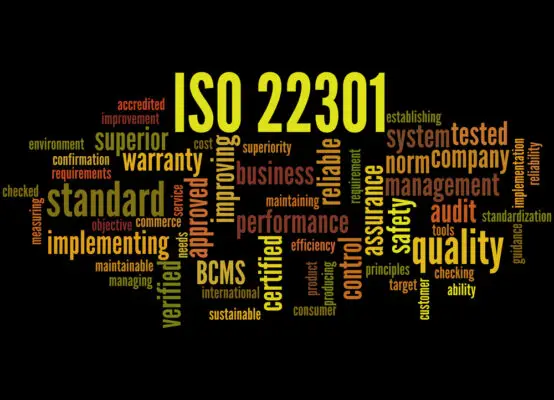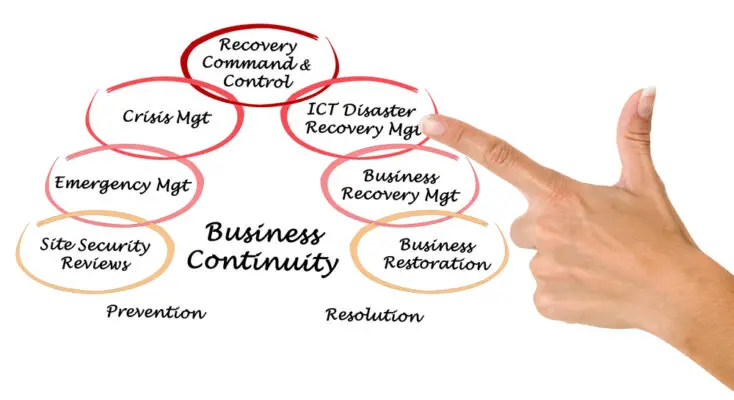When it comes to disaster recovery and business continuity, it’s essential to understand the difference between Recovery Point Objective (RPO) and Recovery Time Objective (RTO). Rpo versus rto are both important elements of any successful data protection strategy for senior management, yet each serves a different purpose. Let’s take a closer look at what sets them apart. Both elements are used in business impact analysis and recovery objectives of BCP.
Recovery Point Objective (RPO)
it is the point in time before an incident or disaster that data needs to be recovered from to avoid any information loss. The more recent the data, the lower the RPO has to be for a business to remain operational after a disaster. For example, if you have an RPO of 24 hours, then your system must be able to recover all data up until 24 hours before the incident or disaster.
RPO is the maximum amount of data you can expect to lose in an outage or disaster. In other words, it’s how far back in time your data recovery needs to go when restoring your system. For example, if your RPO is set for one hour, you can expect to lose up to one hour’s worth of data. The lower your RPO is set, the less you will have to worry about lost data from an outage or disaster.
Recovery Time Objective (RTO)
Conversely, RTO refers to how quickly you need to recover from an outage or disaster for operations to continue as normal. In other words, this is how long it takes to get back online after an incident.
This includes not only getting back online but also all necessary steps that must be taken for operations to resume as normal. The lower your RTO is set, the faster you can expect operations to resume following an incident.
The key difference between these two parameters lies in their purpose; while RPO measures how much data can be lost during an outage or disaster, RTO measures how quickly operations can resume after such an incident occurs.
As such, they both play important roles in any successful data protection strategy and should be carefully considered when planning for disasters and outages.
RPO (Recovery Point Objective) and RTO (Recovery Time Objective) are two key components of a business continuity plan.
RPO refers to the maximum amount of data that can be lost in an emergency situation. At the same time, RTO is the maximum amount of time it takes to restore operations after a disruption.
For example, if the RPO is set at 24 hours, then any data created or changed within the past 24 hours must be recovered for operations to resume.
The RTO sets a target time for how quickly services should be restored after a disruption occurs; if this goal isn’t met, there may be significant financial losses or reputational damage associated with it.
RTO (Recovery Time Objective) and RPO ( Recovery Point Objective ) are key factors businesses must define for developing a business continuity recovery plan. Both metrics are used for designing the recovery processes — setting recovery times, frequency of backups — and recovering procedures.
Although RTO is similar to RPO, there is one important difference. We will review recovery time and recovery point objective concepts as they have different characteristics.
Are your business operations prepared to resume seamlessly after a disaster? Knowing the difference between recovery point objective (RPO) and recovery time objective (RTO), two essential components of disaster recovery planning, is critical for any business that wants to ensure a return to normal business operations.
This blog post will help you understand better RPO vs. RTO, so you’ll know how to protect your data securely and be back up and running as quickly as possible in case of an unexpected event.

RTO and RPO: Disaster Recovery Strategy Essentials
Disaster recovery is an essential part of any modern business strategy; having the right tools and plans in place can make all the difference. RTO (Recovery Time Objective) and RPO (Recovery Point Objective) are two of the most important elements to develop a disaster recovery plan.
RTO sets the amount of time a business must wait to recover before critical operations come back up after a major outage. Meanwhile, to ensure that data remains resilient and current, RPO measures how often backups occur to restore data accurately in case of an emergency.
A well-rounded disaster recovery plan should utilize these mechanisms as part of a larger strategy with check-ins and simulations for continued success.
Disaster Recovery Planning
Disaster recovery planning is an important task for businesses to ensure continued operations in the wake of any unforeseen disasters. It combines the use of a Recovery Point Objective (RPO) and Recovery Time Objective (RTO). RPO determines how much data needs to be backed up from frequent intervals, while RTO defines a timeframe within which normal operations must be restored.
The key point to consider during disaster recovery planning is that it should involve both IT and business operations departments, as they need to collaborate closely and plan accordingly. For faster data recovery, companies may also want to consider investing in alternative storage solutions such as cloud-based systems.
Through taking into account all these factors and more, organizations can create reliable disaster recovery plans that will help them get back up on their feet quickly in times of crisis.
Recovery Point Objective (RPO)
RPO is viewed, however, as a company’s loss tolerance or how much data is ready for loss in the event of a catastrophe. The manager should determine the amount of time he can spend without obtaining information prior to affecting his objectives.
How to Calculate RTO and RPO
The calculation method of RTO is not suited to all companies or systems. The BI analysis of a portfolio of assets includes the following: Once the system is fully understandable, the analysis team will determine the best RTO.
The next step is to consult the company leaders and executive leadership to determine whether this proposed RTO is feasible on the budget. Rapidly means cheaper when RTOs exist.

How to Calculate RTO and RPO
Calculating Recovery Time Objective (RTO) and Recovery Point Objective (RPO) is a crucial. Here are the steps for calculating these values:
Identify Critical Functions: Identify the essential functions that must be recovered to keep business operations running smoothly during an event or disruption.
Determine Maximum Tolerable Downtime: Estimate the maximum amount of downtime the organization can tolerate for each critical function identified in step 1. This will help you determine the RTO for each critical function and the overall RTO for your organization.
Calculate Back-Up Interval: To calculate the RPO, determine how often data backups should occur to achieve acceptable data loss if a disaster occurs. Determine how much data loss and if scheduled backup storage works for critical data.
Apply Risk Adjustments: Once you have determined both the RTO and RPO values, review them to ensure they reflect any risk adjustments needed to account for unforeseen events or added requirements that may arise due to unexpected circumstances.
Examples of RPO and RTO
Recovery Point Objective (RPO) and Recovery Time Objective (RTO) can vary depending on the organization’s needs. Here are some examples of what they may look like:
Example 1 – Low-risk Organization: The RPO could be 24 hours for a low-risk organization with an RTO of 48 hours. This means backups should occur every 24 hours, and any critical functions must be recovered within 48 hours of a disaster.
Example 2 – Medium-Risk Organization: The RPO could be 4 hours for a medium-risk organization with an RTO of 12 hours. This means that backups should occur every 4 hours, and any critical functions must be recovered within 12 hours of a disaster.
Example 3 – High-Risk Organization: The RPO could be 1 hour for a high-risk organization with an RTO of 6 hours. This means backups should occur every hour, and any critical functions must be recovered within 6 hours of a disaster.
Recovery Time Objective (RTO)
The RTA timeline is determined by business implications analysis during business continuity planning. The results reflect a strategic decision by senior leadership to restore the company s IT operations and reflect the goal period.
RTO vs RPO Main Differences
These are RTO and RPO, representing time measurements that can help with effective catastrophe recovery. Both require comprehensive plans and a proactive security mentality, but the RTO/RPO differs in several areas. Together, RTO and RPO help businesses decide how long the company can afford to lose data after recovering.
Most businesses want to return from disruption immediately, but the longer RTOs and RPOs are, the greater the recovery costs (and vice versa). How can he guarantee the lowest RTOs with minimal upfront investment?
What is the difference between Recovery Point Objective and Recovery Time Objective?
Although the two recovery goals differ in measurement metrics, their focus is different based on application priorities.
Recovery Point Objective (RPO) and Recovery Time Objective (RTO) are two key components of a disaster recovery plan. While they are closely related, they measure different aspects of the process.
Recovery Point Objective: RPO defines the maximum allowable amount of data loss. It is measured in terms of time and corresponds to how often backups should be taken to minimize data loss during a disaster
Recovery Time Objective: RTO defines the maximum acceptable amount of time it takes to recover from a disruption or disaster. It is measured in terms of time and corresponds to how quickly critical functions must be recovered for operations to resume.
Block recovery process
A block recovery process is a method of restoring data from backup copies in the event of data loss. It involves taking a copy of the entire database or volume and restoring it to a specific point in time. This means that all changes made since that point will be lost.
To perform a block recovery, you must have access to the backups taken prior to the disaster event. These backups should contain all required information for successful recovery. The process typically involves copying these backups to an alternate server and then restoring them into place.

Regular data backup checks
This policy aims to ensure that you are protected against any threats to your data should an incident arise.
Regular data backup checks are an essential part of any disaster recovery plan. By regularly checking the integrity of backups, businesses can ensure that their data is up to date and recoverable in case of an emergency.
To perform regular data backup checks, administrators should check that the backup system is running properly and taking regular snapshots as intended. They should also verify that all files, folders, emails, and applications are backed up correctly. Additionally, they should ensure that there is sufficient free space in the storage location to accommodate new backups.
Finally, administrators should periodically test the disaster recovery process by restoring a backup onto a separate machine or environment to confirm its validity. This helps guarantee that data will be available for recovery in case of an actual disaster.
How RTO and RPO could develop over time?
For example, the cost of a disaster can affect an entire business. Another factor that may affect your prioritization of your RPOs or RTOs is internal and external developments within your company.
Influential changes include service provision additions, structure changes, staffing changes, data growth, and location changes. It could change objectives completely. It must be a routine testing exercise demonstrating that disaster recovery can easily happen.
Conclusion
Understanding the difference between Recovery Point Objective (RPO) and Recovery Time Objective (RTO) is essential for any business that wants a comprehensive disaster recovery plan in place. While RPO measures how much data can be lost during an outage or disaster, RTO measures how quickly operations can resume after such an incident occurs.
By considering both parameters when planning for future outages and disasters, businesses can ensure that their systems are always up-to-date and secure—no matter what may come their way.
Have you read?
Key components of business continuity management system
How to create a business continuity plan
Key elements of a business continuity management system
Bcms business continuity management system
How to perform a business impact analysis
What is business impact analysis( BIA)

Chris Ekai is a Risk Management expert with over 10 years of experience in the field. He has a Master’s(MSc) degree in Risk Management from University of Portsmouth and is a CPA and Finance professional. He currently works as a Content Manager at Risk Publishing, writing about Enterprise Risk Management, Business Continuity Management and Project Management.

